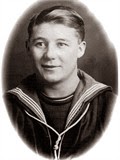Bertie Pinnuck was a second cousin once removed of my great
grandmother Ellen Pinnuck (1855-1913), who married Robert Melton Armitage
(1846-1910) in 1876. Bertie was born on the 28th April 1899 in
Enfield. He was the fourth of nine children born to William Frederick and Clara
Pinnuck. William, a labourer, died in 1909 aged 36.
When war was declared in 1914, many men rushed to volunteer.
However, as the casualty toll rose, the British Armed Services began to run out
of men and so conscription was introduced in 1916. Bertie became eligible for
war service in April 1917, when he reached the age of 18. The papers relating
to 8,000 appeals against conscription in Middlesex have survived and are held
by the National Archives. They include an application made by Clara Pinnuck for
Bertie to be exempted. It was considered by a tribunal in Enfield on June 1st
1917. Bertie was then living with his mother at 21 Walton Street, Enfield and
working as a “fancy portmanteau maker”. Clara provided the following reasons in
support of the application:
I have had two of my
sons in France one killed other one still out there and all I get is 12/6 from
the Government and I am a widow with four others under
14 years and this son is my sole
support and if you take him I don’t know what I shall do as he is the main stay
of the house.
(The son that was killed was William George Pinnuck, who died
at Ypres in 1915 aged 18. The other son was Charles Ambrose Pinnuck, born 1894,
who was a Gunner in the Royal Garrison Artillery. He survived the war and died
in 1940).
The tribunal granted exemption for a period of six months
from June 1st 1917 on condition that Bertie paid his mother £1 per
week and became an active member of a Volunteer Regiment – Domestic position.
The Chief Military Representative appealed against this
decision on June 4th 1917 stating:
That in view of the
urgent and pressing need for men passed for General Service in the Army, it is
necessary to appeal against the decision of the Tribunal who granted him six
months. His occupation is not of national importance, he was allowing his
mother 17/- per week for his board and lodging until at the advice of some of
the Members he allowed her 20/- per week. I submit there was no justification
for the Tribunal to grant six months exemption when men are so urgently wanted
and married men with heavy responsibilities have been compelled to join up.
The appeal was considered at The Guildhall, Westminster on
June 20th 1917 and dismissed.
Bertie joined the Royal Navy on January 29th
1918. His service record states his occupation as carman, height 5 foot 4½
inches, hair brown, eyes hazel, complexion fresh.
Bertie in his Royal Navy
uniform
Bertie was recruited as a Stoker and was initially assigned
to HMS Vivid II, which was the name of the Navy Barracks at Devonport. On April
2nd 1918 he was assigned to HMS Cumberland, an armoured cruiser completed in
1903. From January 1915 until the end of the war, she escorted convoys and
conducted patrols against German raiders seeking to attack merchant ships. The
ship had a complement of 678 officers and men. It had a top speed of 23 knots
and was powered by steam engines. Bertie’s job was to shovel coal into the
boilers, which was hot and tiring work. He was demobilised on February 11th
1919. His character is recorded as very good, his ability as satisfactory.
HMS Cumberland
On April 9th 1921, Bertie married Alice Aggus at
Jesus Church, Enfield. The marriage register says that he was aged 23 (he was
actually not quite 22) and a farm labourer. It says that she was 24 (she was
actually 27), a domestic servant, the daughter of John Aggus (deceased), a farm
labourer.
Alice Pinnuck nee
Aggus
The 1921 census shows Bertie (aged 23) and Alice (25) Pinnuck as boarders at The Cottage, White Webbs Farm, Enfield. This was the address of John Aggus (Alice's brother) and his wife Emily. Bertie was a woodman, working for Admiral Sir Hedworth Meux on his estate at Theobalds Park in Cheshunt, Hertfordshire.
Alice died in 1967 aged 73, Bertie died in 1982 aged 82, both in Enfield.


